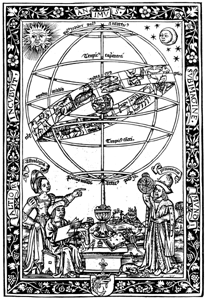<Back to Index>
- Astronomer Georg von Peuerbach, 1423
- Poet Alfred Austin, 1835
- Emperor of the Song Dynasty Renzong, 1010
PAGE SPONSOR

Georg von Peuerbach (also Purbach, Peurbach, Purbachius, his real surname is unknown) (born May 30, 1423 in Peuerbach near Linz – April 8, 1461 in Vienna) was an Austrian astronomer, mathematician and instrument maker.
About the year 1440 Peuerbach received the degree of master of philosophy and the free arts, cum insigni laude, at the University of Vienna. His teacher in mathematics was probably Johann von Gmünden.
In 1448 Peuerbach went on a trip to Italy for the sake of study. There, Giovanni Bianchini of Ferrara and Cardinal Nicholas of Cusa, then in Rome, became interested in the young man and induced him to lecture on astronomy at the University of Ferrara. He refused offers of professorships at Bologna and Padua, and also the appointment as court astronomer to King Ladislaus of Hungary, but went back to Vienna in 1450 to teach. He lectured on philology and classical literature. His scientific teaching was done chiefly in private, his most famous pupil being Johann Müller of Königsberg, later known as Regiomontanus.
Purbach has been called the father of mathematical and observational astronomy in the West. He began to work up Ptolemy's Almagest and Alhazen's On the Configuration of the World. He replaced Ptolemy's chords with the sines from Arabic mathematics, and calculated tables of sines for every minute of arc for a radius of 600,000 units. This was the first transition from the duodecimal to the decimal system. His observations were made with very simple instruments, an ordinary plumb - line being used for measuring the angles of elevation of the stars. Cardinal Bessarion invited him to Rome to study Ptolemy in the original Greek and not from a faulty Latin translation. He accepted on condition that Müller go with him. On account of the master's death the pupil went alone to complete the work.
Purbach is also noted for his great attempt to reconcile the opposing theories of the universe, the so - called homocentric spheres of Eudoxus of Cnidus and Aristotle, with Ptolemy's epicyclic trains. This work, Theoricæ novæ planetarum, had an enormous success and remained the basis of academic instruction in astronomy until years after Nicolaus Copernicus had swept away all these hypotheses.
He worked at the Observatory of Varadinum (also called Großwardein / Oradea / Nagyvárad) in Transylvania and established in his "Tabula Varadiensis" the town's observatory as lying on the prime meridian of Earth.